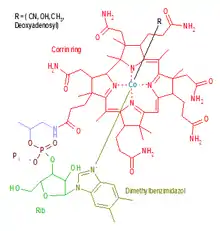Corrinoid
Corrinoids are a group of compounds based on the skeleton of corrin, a cyclic system containing four pyrrole rings similar to porphyrins.[2] These include compounds based on octadehydrocorrin, which has the trivial name corrole.[3]

Vitamin B12 (cyanocobalamin)
The cobalamins (vitamin B12) are the best known members of the group. Other prominent examples include cobyrinic acid and its hexaamide cobyric acid; cobinic acid and its hexaamide cobinamide; cobamic acid and cobamide.
Compounds containing the "Cob-" prefix (not corrin) are cobalt derivatives, and may include an oxidation state, as in "Cob(II)alamin". When cobalt is replaced by another metal or hydrogen, the name changes accordingly, as in ferrobamic acid or hydrogenobamic acid.
References
- Dorothy Crowfoot Hodgkin (1965-11-16). "The Structure of the Corrin Nucleus from X-ray Analysis". Proceedings of the Royal Society of London. Series A, Mathematical and Physical Sciences. 288 (1414): 294–305. Bibcode:1965RSPSA.288..294H. doi:10.1098/rspa.1965.0219. JSTOR 2415001. S2CID 95235740.
- Cracan, Valentin; Banerjee, Ruma (2013). "Chapter 10 Cobalt and Corrinoid Transport and Biochemistry". In Banci, Lucia (ed.). Metallomics and the Cell. Metal Ions in Life Sciences. 12. Springer. pp. 333–374. doi:10.1007/978-94-007-5561-1_10. ISBN 978-94-007-5560-4. PMID 23595677. electronic-book ISBN 978-94-007-5561-1 ISSN 1559-0836 electronic-ISSN 1868-0402
- "The Nomenclature of Corrinoids: Recommendations 1975". IUPAC-IUB Commission on Biochemical Nomenclature (CBN). 1975. Archived from the original on 2012-10-29. Retrieved 2006-06-19.
External links
- Corrinoids at the US National Library of Medicine Medical Subject Headings (MeSH)
- "The Nomenclature of Corrinoids" at chem.qmul.ac.uk
- Goldbook
This article is issued from Wikipedia. The text is licensed under Creative Commons - Attribution - Sharealike. Additional terms may apply for the media files.
